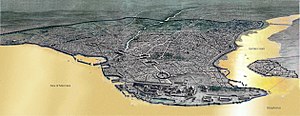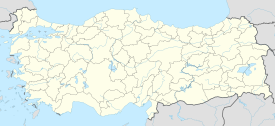
Back Константинополь Abkhazian Konstantinopèl ACE Konstantinopel Afrikaans القسطنطينية Arabic ܩܘܣܛܢܛܝܢܘܦܘܠܝܣ ARC كونستانتينوبوليس ARZ Constantinopla AST Konstantinopol Azerbaijani قوسطنطنیه AZB Канстанцінопаль Byelorussian
 | |
Constantinople was founded on the former site of the Greek colony of Byzantion, which today is known as Istanbul in Turkey. | |
| Location | Fatih and Beyoğlu, Istanbul, Turkey |
|---|---|
| Region | Marmara Region |
| Coordinates | 41°00′45″N 28°58′48″E / 41.01250°N 28.98000°E |
| Type | Imperial city |
| Part of | |
| Area | 6 km2 (2.3 sq mi) enclosed within Constantinian Walls 14 km2 (5.4 sq mi) enclosed within Theodosian Walls |
| History | |
| Builder | Constantine the Great |
| Founded | 11 May 330 |
| Periods | Late antiquity to Late Middle Ages |
| Cultures | |
| Events | Sieges of Constantinople, including fall of the city (1204 and 1453) |
| Official name | Historic Areas of Istanbul |
| Type | Cultural |
| Criteria | (i), (ii), (iii), (iv) |
| Designated | 1985 (9th session) |
| Reference no. | 356bis |
| Extension | 2017 |
| Area | 765.5 ha |
| UNESCO region | Europe and North America |
| Timeline of Constantinople | |
|---|---|
Capital of the Byzantine Empire 395–1204 AD; 1261–1453 AD
|
Constantinople[a] (see other names) became the capital of the Roman Empire during the reign of Constantine the Great in 330. Following the collapse of the Western Roman Empire in the late 5th century, Constantinople remained the capital of the Eastern Roman Empire (also known as the Byzantine Empire; 330–1204 and 1261–1453), the Latin Empire (1204–1261), and the Ottoman Empire (1453–1922). Following the Turkish War of Independence, the Turkish capital then moved to Ankara. Officially renamed Istanbul in 1930, the city is today the largest city in Europe, straddling the Bosporus strait and lying in both Europe and Asia, and the financial centre of Turkey.
In 324, after the Western and Eastern Roman Empires were reunited, the ancient city of Byzantium was selected to serve as the new capital of the Roman Empire, and the city was renamed Nova Roma, or 'New Rome', by Emperor Constantine the Great. On 11 May 330, it was renamed Constantinople and dedicated to Constantine.[6] Constantinople is generally considered to be the center and the "cradle of Orthodox Christian civilization".[7][8] From the mid-5th century to the early 13th century, Constantinople was the largest and wealthiest city in Europe.[9] The city became famous for its architectural masterpieces, such as Hagia Sophia, the cathedral of the Eastern Orthodox Church, which served as the seat of the Ecumenical Patriarchate; the sacred Imperial Palace, where the emperors lived; the Hippodrome; the Golden Gate of the Land Walls; and opulent aristocratic palaces. The University of Constantinople was founded in the 5th century and contained artistic and literary treasures before it was sacked in 1204 and 1453,[10] including its vast Imperial Library which contained the remnants of the Library of Alexandria and had 100,000 volumes.[11] The city was the home of the Ecumenical Patriarch of Constantinople and guardian of Christendom's holiest relics such as the Crown of thorns and the True Cross.

Constantinople was famous for its massive and complex fortifications, which ranked among the most sophisticated defensive architecture of antiquity. The Theodosian Walls consisted of a double wall lying about 2 kilometres (1.2 mi) to the west of the first wall and a moat with palisades in front.[12] Constantinople's location between the Golden Horn and the Sea of Marmara reduced the land area that needed defensive walls. The city was built intentionally to rival Rome, and it was claimed that several elevations within its walls matched Rome's 'seven hills'.[13] The impenetrable defenses enclosed magnificent palaces, domes, and towers, the result of prosperity Constantinople achieved as the gateway between two continents (Europe and Asia) and two seas (the Mediterranean and the Black Sea). Although besieged on numerous occasions by various armies, the defenses of Constantinople proved impenetrable for nearly nine hundred years.
In 1204, however, the armies of the Fourth Crusade took and devastated the city, and for several decades, its inhabitants resided under Latin occupation in a dwindling and depopulated city. In 1261 the Byzantine Emperor Michael VIII Palaiologos liberated the city, and after the restoration under the Palaiologos dynasty, it enjoyed a partial recovery. With the advent of the Ottoman Empire in 1299, the Byzantine Empire began to lose territories, and the city began to lose population. By the early 15th century, the Byzantine Empire was reduced to just Constantinople and its environs, along with Morea in Greece, making it an enclave inside the Ottoman Empire. The city was finally besieged and conquered by the Ottoman Empire in 1453, remaining under its control until the early 20th century, after which it was renamed Istanbul under the Empire's successor state, Turkey.
- ^ Croke, Brian (2001). Count Marcellinus and His Chronicle, p. 103. University Press, Oxford. ISBN 0198150016.
- ^ Müller-Wiener (1977), p. 86.
- ^ "The Chronicle of John Malalas", Bk 18.86 Translated by E. Jeffreys, M. Jeffreys, and R. Scott. Australian Association of Byzantine Studies, 1986 vol 4.
- ^ "The Chronicle of Theophones Confessor: Byzantine and Near Eastern History AD 284-813". Translated with commentary by Cyril Mango and Roger Scott. AM 6030 pg 316, with this note: Theophanes' precise date should be accepted.
- ^ Roach, Peter (2011). Cambridge English Pronouncing Dictionary (18th ed.). Cambridge: Cambridge University Press. ISBN 978-0-521-15253-2.
- ^ Mango, Cyril (1991). "Constantinople". In Kazhdan, Alexander (ed.). The Oxford Dictionary of Byzantium. Oxford and New York: Oxford University Press. pp. 508–512. ISBN 0-19-504652-8.
- ^ Parry, Ken (2009). Christianity: Religions of the World. Infobase Publishing. p. 139. ISBN 9781438106397.
- ^ Parry, Ken (2010). The Blackwell Companion to Eastern Christianity. John Wiley & Sons. p. 368. ISBN 9781444333619.
- ^ Pounds, Norman John Greville. An Historical Geography of Europe, 1500–1840, p. 124. CUP Archive, 1979. ISBN 0-521-22379-2.
- ^ Janin (1964), passim
- ^ "Preserving The Intellectual Heritage--Preface • CLIR". CLIR. Archived from the original on 20 October 2017. Retrieved 9 June 2021.
- ^ Treadgold, Warren (1997). A History of Byzantine State and Society. Stanford, CA: Stanford University Press. p. 89.
- ^ John Julius Norwich writes: "To identity them all needs a good deal more credulity and imagination than is required for their Roman counterparts." Byzantium: The Early Centuries (1989), Guildhall Publishing, p. 76n
Cite error: There are <ref group=lower-alpha> tags or {{efn}} templates on this page, but the references will not show without a {{reflist|group=lower-alpha}} template or {{notelist}} template (see the help page).


